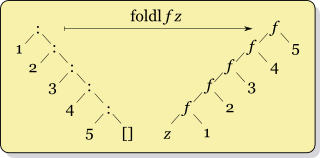- See also
- mim::plug::vec
Utilitly functions for arrays to behave them like vectors in other languages.
Dependencies
plugin core;
plugin refly;
Iterators
%vec.fold
Fold aka Reduction of the vector with f:
%vec.fold.l f (init, (e1, ..., en)) is f (... (f (f (init, e1), e2)) ..., en).%vec.fold.r f ((e1, ..., en), init) is f (e1, f (e2, ... (f (en, init) ...))).
%vec.fold.l | %vec.fold.r |
 |  |
axm %vec.fold(l): {A E: *} → {n: Nat} → [f: [A, E] → A] → [A, «n; E»] → A, normalize_fold;
axm %vec.fold(r): {A E: *} → {n: Nat} → [f: [E, A] → A] → [«n; E», A] → A, normalize_fold;
Scanning
%vec.scan
Does the given predicate hold for all elements/at least one element?
axm %vec.scan(for_all, exists): {E: *} → {n: Nat} → [p: E → Bool] → «n; E» → Bool, normalize_scan;
%vec.first / %vec.last
Is the given element in the vector, and what is the index of its first/last occurence?
lam f_first {E: *} {n: Nat} (eq: [E, E] → Bool) (x: E) ((b: Bool, i: Idx n), y: E): [Bool, Idx n] = (((ff, %core.wrap.add 0 (i, %core.idx n 0 1)), (tt, i))#(eq (x, y)), (b, i))#b;
lam f_last {E: *} {n: Nat} (eq: [E, E] → Bool) (x: E) (y: E, [b: Bool, i: Idx n]): [Bool, Idx n] = f_first eq x ((b, i), y);
lam %vec.first {E: *} {n: Nat} (eq: [E, E] → Bool) (v: «n; E», x: E): [Bool, Idx n] = %vec.fold.l (f_first eq x) ((ff, %core.idx n 0 0), v);
lam %vec.last {E: *} {n: Nat} (eq: [E, E] → Bool) (v: «n; E», x: E): [Bool, Idx n] = %vec.fold.r (f_last eq x) (v, (ff, %core.idx n 0 0));
%vec.len
Get length of vector.
lam %vec.len {n: Nat} {T: *} [«n; T»]: Nat = n;
%vec.is_unique
Checks whether all elements in the given vector are distinct from each other (using structural equivalence).
axm %vec.is_unique: {T: *} → {n: Nat} → «n; T» → Bool, normalize_is_unique;
Modifiers
Concatenation of an n-vector and an m-vector to an n + m-vector.
axm %vec.cat: {n m: Nat}
→ {T: *}
→ [«n; T», «m; T»]
→ «%core.nat.add (n, m); T», normalize_cat;
%vec.diff
Removes elements from vector.
axm %vec.diff: {T: *}
→ {n m: Nat}
→ [«n; T», is: «m; Idx n»]
→ «%refly.check (%vec.is_unique is, %core.nat.sub (n, m), "given indices are not distinct"); T», normalize_diff;

